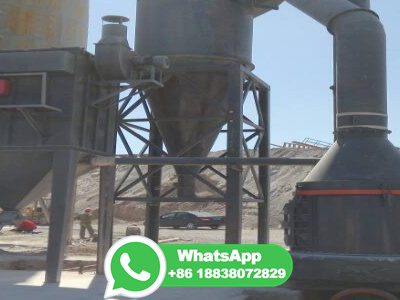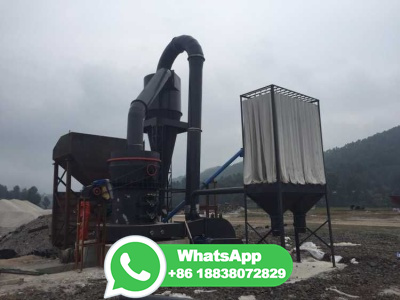
The Bayer process. The Bayer process. Bauxite has to be processed into pure aluminium oxide (alumina) before it can be converted to aluminium by electrolysis. This is achieved through the use of the Bayer chemical process in alumina refineries. The aluminium oxide is released from the other substances in bauxite in a caustic soda solution ...
WhatsApp: +86 18037808511
The Bayer process is not easily explained in brief. This method of obtaining alumina from bauxite ore is complex and involves a lengthy succession of chemical reactions, with the process varying slightly depending on the makeup of the unique source of bauxite ore. Crushed and washed bauxite ore must first go through a process to remove any ...
WhatsApp: +86 18037808511
Introduction. Bauxite residue, or red mud, is a solid waste produced from the alumina refining of bauxite ore. Red mud is mostly collected from the Bayer process which uses sodium hydroxide to dissolve the aluminium silicate. Typically, about 1 to tonnes of red mud remains from the production of 1 t of alumina (Zhang et al., 2011).
WhatsApp: +86 18037808511
Bayer Process A process flow diagram of the Bayer process is shown in Exhibit 3. The primary purpose of a Bayer plant is to process bauxite to provide pure alumina for the production of aluminum. All bauxite refineries share five common process steps: (1) ore preparation; (2) bauxite digestion; (3) clarification; (4) aluminum hydroxide precipi ...
WhatsApp: +86 18037808511
The excessive production of bauxite residue (red mud) in the Bayer process is one of the major challenges amongst alumina producers. The Pedersen process is known as a combination of smelting reduction of bauxite and leaching treatment of the produced slag for alumina production, and the process also produces an inert bauxite residue (grey mud), which is more suitable for further processing ...
WhatsApp: +86 18037808511
In the Bayer process, bauxite ore is digested in a highly concentrated caustic soda solution, usually at elevated temperatures and pressures. The process relies upon the lower solubility of the hydroxides of most metals relative to aluminium, but under these conditions it is inevitable
WhatsApp: +86 18037808511
Process Description 23 Primary aluminum production begins with the mining of bauxite ore, a hydrated oxide of aluminum consisting of 30 to 56 percent alumina (A l2O3) and lesser amounts of iron, silicon, and titanium. The ore is refined into alumina by the Bayer process. The alumina is then shipped to a primary aluminum plant for
WhatsApp: +86 18037808511
The Bayer process is used for refining bauxite to smelting grade alumina, the precursor to aluminum. Typically, depending upon the quality of the ore, between and tonnes of bauxite is required to produce 1 ton of alumina. The Bayer process involves the digestion of crushed bauxite in the concentrated sodium hydroxide (caustic) solution at
WhatsApp: +86 18037808511
The Bayer Process: From Bauxite 20 to Aluminum Hydroxide To avoid any misunderstanding: The Bayer process has nothing to do with the worldfamous chemical company that produces aspirin, among other things. It is the main production method of aluminium oxide, named after its relatively unknown inventor.
WhatsApp: +86 18037808511
In 2020, the reported quantity of bauxite consumed was estimated to be 4 million tons, slightly more than that reported in 2019, with an estimated value of about 110 million. About 79% of the bauxite was refined by the Bayer process for alumina or aluminum hydroxide, and the remainder went to products such as
WhatsApp: +86 18037808511
The Bayer process involves four steps: digestion, clarification, precipitation, and calcination. Other articles where Bayer process is discussed: alumina: .extracted from bauxite through the Bayer process, which was developed for the aluminum industry in 1888. In the Bayer process bauxite is crushed, mixed in a solution of sodium hydroxide ...
WhatsApp: +86 18037808511
The Bayer process liquor cycle is a loop, and the goal is to ensure that the energy stays within the loop, with heat exchange occurring between different parts of the cycle. The diagram shown in Fig., provided by Donaldson, simplifying the Bayer process into a large heat exchanger, highlights this idea well. Wherever possible the heat is ...
WhatsApp: +86 18037808511
Bauxite is mainly composed of alumina, silica, iron oxide and titanium dioxide. Around 70% of bauxite ore in the world adopts Bayer process to produce alumina. Then by HallHéroult electronic process, alumina can be reduced to pure aluminum. Bayer process steps for alumina production
WhatsApp: +86 18037808511
The Bayer process produces pure aluminium hydroxide from bauxite. As shown in the figure below, this process utilises the different thermodynamic properties of the caustic soda aluminium hydroxide system and typically consists of the following stages: bauxite crushing grinding, leaching, physical separation, precipitation and ...
WhatsApp: +86 18037808511
Bauxite is the principal ore of aluminum. The first step in producing aluminum is to crush the bauxite and purify it using the Bayer Process. In the Bayer Process, the bauxite is washed in a hot solution of sodium hydroxide, which leaches aluminum from the bauxite. The aluminum is precipitated out of solution in the form of aluminum hydroxide ...
WhatsApp: +86 18037808511
The ore is first converted into pure aluminum oxide by the Bayer Process, and this is then electrolyzed in solution in molten cryolite another aluminum compound. The aluminum oxide has too high a melting point to electrolyse on its own. The usual aluminum ore is bauxite. Bauxite is essentially an impure aluminum oxide.
WhatsApp: +86 18037808511
The plant is a complete closed circuit Bayer process facilityembracing the unit operations of an industrial scale Bayer alumina plant up to the hydrate production stage. It can operate at digestion temperatures up to 2600C and can process a minimum of 20 tons of bauxite continuously over a onemonth period. The minimum production rate is 10 kg ...
WhatsApp: +86 18037808511
BAUXITE TO ALUMINA: THE BAYER PROCESS An Introductory Text 1. Introduction Aluminium is the most abundant metal in the Earth's crust. Unlike metals such as copper and gold, it is never found by itself, but always in combination with the most abundant element, oxygen, and often with the second and fourth most abundant elements, silicon and iron.
WhatsApp: +86 18037808511
Bauxite residue is the industrial solid waste discharged from the production of alumina by bauxite, which contains a certain amount of ferric oxide in a reddishbrown color, so it is also called "red mud", and is a typical nonferrous metallurgical solid waste (Wang et al. 2018; Xue et al. 2022).The varieties of bauxite residue depend on the grade of the bauxite and alumina production process.
WhatsApp: +86 18037808511
The Bayer process is used for refining bauxite to smelting grade alumina (Al 2 O 3 ), the precursor to aluminium. The process was developed and patented by Karl Josef Bayer 110 years ago, and has become the cornerstone of the aluminium production industry worldwide. Production of alumina reached megatonnes (Mt) worldwide by the end of 1997 ...
WhatsApp: +86 18037808511
During the Bayer process, the bulk of REEs is almost entirely transferred to bauxite residue, based on case studies of lanthanum, scandium, cerium and yttrium distribution in the Bayer process . Depending on the concentration of REEs in the bauxite ore, bauxite residue can have a concentration of total REEs up to 2500 mg/kg such as in the case ...
WhatsApp: +86 18037808511
The Bayer process is a chemical process for refining aluminium hydroxide, Al(OH) 3 from bauxite; this aluminium hydroxide is subsequently calcined to produce alumina, Al 2 O basis of the Bayer process is an understanding of the characteristics of the sodiumhydroxide—sodiumaluminate solution relationship, namely its ability to keep sodiumaluminate in a dissolved state over a wide ...
WhatsApp: +86 18037808511
Bauxite is transformed into sodiumcontaminated gibbsite in the socalled Bayer process (32,33). Industrial Bayertype gibbsite can be redissolved in acids or in strongly basic solutions, and from these solutions all other aluminum compounds are produced including aluminum hydroxides and oxides (34,35) .
WhatsApp: +86 18037808511
The Bayer process, with various modifications, is the most widely used method for the production of alumina, and all aluminum is produced from alumina using the HallHéroult electrolytic process. Refining the ore. aluminum processing: Bayer process. Principal operations in the Bayer process of refining bauxite to alumina. (more) There are a ...
WhatsApp: +86 18037808511
The Bayer process is used for producing alumina (Al 2 O 3) from bauxite process was developed and patented by Karl Josef Bayer in 1887 [], which led to a dramatic reduction in the cost of aluminium process involves the following operations: mining, dissolution of the alumina at elevated temperatures, the addition of flocculants, precipitation of pure gibbsite, regeneration of ...
WhatsApp: +86 18037808511
Alumina Extraction Problem. In the standard Bayer Process for refining bauxite to produce alumina, the dissolution of the alumina in the ore to form sodium aluminate is accomplished in autoclaves under high pressures varying from 70 to 200 pounds per square inch. However, some lateritic bauxite ores are readily soluble in caustic, making it ...
WhatsApp: +86 18037808511
Bauxite residue (BR) is a solid waste generated from the Bayer process during alumina production after the significant removal of water from red mud [1, 2]. Iron contained in the BR is high and ...
WhatsApp: +86 18037808511
Red mud, now more frequently termed bauxite residue, is an industrial waste generated during the processing of bauxite into alumina using the Bayer process. It is composed of various oxide compounds, including the iron oxides which give its red colour. Over 95% of the alumina produced globally is through the Bayer process; for every tonne of ...
WhatsApp: +86 18037808511
The Bayer Process is the most economic means of obtaining alumina from bauxite. Other processes for obtaining alumina from metal ores are also in use in some refineries, particularly in China and Russia, although these make up a relatively small percentage of global production. The process stages are: 1. Milling
WhatsApp: +86 18037808511
The digestion behavior of Australian gibbsiteboehmite bauxite and pure quartz in the Bayer process at 230250 °C was systematically studied in this paper. The mineral composition and morphology of the reaction products were characterized and the kinetics of the quartz dissolution process was studied in detail. It was shown that boehmite in ...
WhatsApp: +86 18037808511
These refineries use the Bayer Process to extract aluminum hydroxide from the bauxite using hot caustic liquor. Aluminum oxide, Al 2 O 3, is a typical amphoteric oxide, which dissolves in a strong acid and a strong base.
WhatsApp: +86 18037808511
The Bayer process is the most commonly used in alumina production (Liu et al. 2007), and more than 90% of alumina is produced by the Bayer process worldwide (Wang et al. 2018). Bayer red mud is an insoluble alkaline solid waste residue produced during the dissolution process of bauxite by the Bayer process (Zeng et al. 2022; Lyu et al. 2021 ...
WhatsApp: +86 18037808511
The Bayer process was invented 130 years ago and remains the global method of choice for converting bauxite to alumina for aluminum and industrial alumina production. In general, the three largest problems in the Bayer process are as follows: (a) The removal of silica (a problem with high silica bauxite). (b)
WhatsApp: +86 18037808511
In 2020, Bayer settled most of the thenpending Roundup cases for up to billion. Around 50,000 claims remain pending, according to regulatory filings. Reporting by Tom Hals in Wilmington ...
WhatsApp: +86 18037808511
The Bayer process for alumina production generates more than 160 million tons of bauxite residue annually. The current global stockpiles of bauxite residue have reached more than 4 billion tons ...
WhatsApp: +86 18037808511